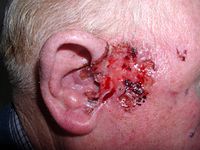
Photo from wikipedia
Dear Editor Nevoid basal cell carcinoma syndrome (NBCCS), also referred as Gorlin–Goltz syndrome, is a rare, autosomal-dominant syndrome, caused by abnormalities in the sonic hedgehog signaling pathway and characterized by… Click to show full abstract
Dear Editor Nevoid basal cell carcinoma syndrome (NBCCS), also referred as Gorlin–Goltz syndrome, is a rare, autosomal-dominant syndrome, caused by abnormalities in the sonic hedgehog signaling pathway and characterized by a multitude of basal cell carcinomas (BCCs), usually developed in a young age. Treatment of BCCs in patients with NBCCS can be extremely challenging due to the high burden of tumors that require multiple surgical excisions, often resulting in disfigurement and emotional distress. Radiotherapy use in NBCCS patients is controversial because of the carcinogenic effect of x-rays that could lead to the formation of new BCCs. In patients who are not candidate for surgery or other treatment approaches, systemic therapy with hedgehog pathway inhibitor (HPI) is recommended, even if reimbursed only in case of advanced and/or metastatic tumors. Vismodegib and sonidegib are specific inhibitors of smoothened, a crucial oncogenic protein of the hedgehog pathway, currently approved for the treatment of advanced BCC; both drugs have been investigated in patients with NBCCS, showing objective response rate in about 60% of patients, even if associated with poor tolerability. We report the case of an 89-year-old woman with NBCCS examined for the presence of a large ulcerated BCC located on the chin, causing continues bleeding and quality of life impairment. NBCCS diagnosis was established by the presence of three major criteria (multiple BCCs, odontogenic keratocysts, and family history of NBCC) and one minor criteria (Patched mutation). Patient's medical history showed that she previously underwent multiple surgical excisions and had been successfully treated with vismodegib 150 mg/die for one large ulcerated BCC on the right nasal fold, one ulcerated BCC on the upper lip and an infiltrating BCC on the chin. The patient also had >50 superficial BCCs on the vertebral region. After 6 months of vismodegib, severe asthenia led to drug discontinuation. The patient was lost to follow-up and was visited again 36 months after the vismodegib interruption because of relapse of all BCCs previously treated, in particular one large ulcerated lesion located on the chin. Physical examination also showed two large ulcerated nodules located on the right nasal fold and upper lip (Figure 1A) which were considered noneligible to surgery and multiple superficial BCCs on the back (Figure 1B). Since according to the Italian rule we cannot prescribe again a HPI after a discontinuation lasting more than 2 months, treatment with sonidegib (200 mg/die) was initiated after approval of the Italian Medical Agency and patient's written informed consent. After 3 months of sonidegib treatment, partial re-epithelization and shrinkage in all the target lesions was observed, with no drug-related
Journal Title: Dermatologic Therapy
Year Published: 2021
Link to full text (if available)
Share on Social Media: Sign Up to like & get
recommendations!